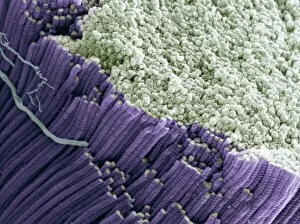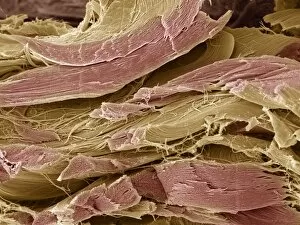Inelastic Collection
Inelasticity is a fascinating characteristic observed in various biological structures, such as tendons
For sale as Licensed Images
Choose your image, Select your licence and Download the media
Inelasticity is a fascinating characteristic observed in various biological structures, such as tendons. Tendons, which connect muscles to bones, play a crucial role in our body's movement and stability. Through the use of scanning electron microscopy (SEM), scientists have been able to delve deeper into understanding the intricate nature of tendon fibers. Under SEM, tendon fibers reveal their remarkable composition and organization. The high-resolution images showcase the dense arrangement of collagen fibers that form these strong yet flexible structures. These microscopic views provide valuable insights into how tendons withstand immense forces while maintaining their shape. The SEM images highlight the unique properties of tendon fibres that contribute to their inelastic behavior. Unlike elastic materials that can stretch and return to their original shape effortlessly, tendons exhibit limited elasticity due to their densely packed collagen bundles. This lack of elasticity ensures precise transmission of force from muscle contraction to bone movement during physical activities. By studying these intricate details using SEM technology, researchers gain a better understanding of how injuries or diseases affect tendon function. Injuries like tears or ruptures can disrupt the alignment and integrity of tendon fibers, leading to reduced strength and impaired mobility. Understanding the inelastic nature of tendons through SEM imaging aids medical professionals in developing effective treatment strategies for conditions like tendinitis or sports-related injuries. By visualizing these microstructural changes at an unprecedented level, clinicians can tailor rehabilitation programs specifically targeting damaged areas within tendons. Exploring the world beneath our skin with SEM reveals awe-inspiring details about tissues like tendons – resilient structures responsible for supporting our movements every day. Unveiling this hidden beauty not only deepens our knowledge but also paves the way for advancements in healthcare aimed at preserving and restoring optimal functionality within our bodies.


